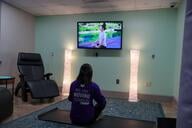You have /5 articles left.
Sign up for a free account or log in.

Istockphoto.com/sorbetto
On a Monday last semester, I sat in the back of a long, narrow room for a campus committee meeting listening to a presentation about how the expectations of college students who are millennials differed from those who are Generation Z. In that presentation, an administrator commented about how faculty members will need to change to meet the demands of both student generations by becoming more available across various platforms and modalities.
Later, I reflected on what was missing from that conversation. As a faculty member and academic administrator, I have witnessed growing expectations in many other areas. We certainly need to better understand changing demographics to foster positive student experiences for everyone. But without time, space and strategies to do so, I fear I will continue to witness colleagues looking haggard and stressed out earlier and earlier each semester. The relentless expansion of expectations can push work hours and stress levels higher and higher, especially for adjunct, term and untenured faculty members.
As a higher education scholar, it is easy to name the culprits for this stretched and stressed behavior. Deadlines. Conferences. Presentations. Budget cuts and deficits. Pressure to publish more and teach better. A changing classroom climate. Heightened student expectations. Ever-present crises. Growing service requirements. Outreach. Recruitment. Program marketing. More grant writing to support institutional budgets. Demands for greater availability in person and online, including on social media. And all of this looks different -- and usually even more overwhelming -- for minoritized and underrepresented faculty.
I see all of these culprits at my own institution, as we are working out of a structural deficit. I have conversations with graduate students about how the growing demands are opportunities to re-evaluate our values, prioritize mission-critical tasks and use that knowledge to excel in selected areas. I also talk about the dangers of continuing a “do it all” mentality or a “do more with less” approach and how to negotiate boundaries within their work spaces. The risks to individual well-being and departmental or institutional morale greatly influence the retention of high-quality students, faculty and staff.
Given all the rapidly increasing expectations, we have limited to zero time each day to reflect and contemplate how to shift paradigms and pedagogical tools to better meet the needs of the incoming generations. We need personal time and space to ensure we can show up wholly and fully rather than stressed and stretched. To create that time, we must be skilled in how to create boundaries that fit our lives and workplace. But in my coaching and advising work, I often observe how people are not confident in what boundaries are and how to create them. Boundary creation is a learned skill, and I know that, personally, I lacked role models in the workplace who did this, let alone did it well.
I’ve had to resolve things on my own, and for those of you in a similar situation, I offer three ways I have learned to create space within my week to allow time to consider how to be innovative and respond to changing demographics and expectations.
Be available and have boundaries on your time. Some simple but intentional decisions have allowed me to increase my accessibility within boundaries that are right for me. For example, I use an online scheduler program so students can make appointments at their convenience with preset days and times that work for me. My available number of hours has stayed the same, and my accessibly has grown. Students can select the meeting in person or by phone or video. The appointments then show up on my calendar without the previous emailing back and forth on our parts.
Students no longer need to ask how to reach me; the appointment link stays in my email signature line. I no longer stress in the evenings or weekends about missing important messages, because I know people can book time with me as they think about it.
I schedule in my writing time and personal care, such as exercise and mindfulness. That has given me downtime at home to rejuvenate rather than just extend my work. Being available to students and having boundaries around time can be a both/and decision.
Schedule reflection time into your calendar. Last year, in order to continue to show up each day available to support and aid other people in their journey, I did what felt like a revolutionary thing: I scheduled an hour a day into my calendar for reflection. It was not catch-up-on-email time. It was stillness. I was returning from a year’s sabbatical, where it took me half the year to unlearn chronic busyness and the next half to relearn balance, and I did not want to lose those lessons. That hour, which I blocked out in the morning of my work calendar, was my boundary around my well-being within work.
For me, that hour often took the form of meditation and/or journaling. Some days it was sitting on a park bench or going for a walk around campus. It was tuning in to my breath. It was slowing down the fight-or-flight signals in my body that trigger stress and cortisol release. By having this time each day, I found I was more prepared to actively be present, listen and respond to the needs of others.
At first, it seemed extravagant, but now it is vital to my day and ability to function optimally and wholly. While I haven’t always been successful scheduling time for it, it’s a practice I will continue as much as possible each workweek.
Evaluate commitments. This recommendation will probably not win me praise from other administrators. But in a world where demands for time come rapidly from all corners, it is necessary to say no. I am not a proponent of doing more with less, as I’ve stated, although it took me years of burnout behaviors to learn this lesson. Less is less. Prioritizing my work is necessary for me to do a good job and to avoid repeating that burnout. Additionally, I try to communicate this to my students. In role modeling as a professional in my field, it means being transparent about my commitments and what gets my time each week.
During my scheduled reflection times, I can ask myself these questions whenever I get a request:
- Is this something I really want to do?
- Will it benefit my work in this program/university/field?
If my answer to both is yes, then the next question is, “What can I let go of in the week to accommodate this?” If my answer to either is no, then I evaluate how I get myself to a space to say no respectfully.
Going back to the committee example I started with, I noticed I often felt more stressed before, during and after such meetings, because they took up a big chunk of my Mondays and sometimes other days. Was it good service? Absolutely. Was my voice helpful? I hope so. But was my attendance crucial for meeting the goals for my work in the program/university/field? No, I did not see evidence of that. In the end, I evaluated, prioritized and decided to stop participating in order to shift my focus to other services that fit my values and benefit my program more directly.
A Time for Re-Evaluation
It is that period in an academic year when the semester or quarter has settled in and work is underway. Now is a great time to re-evaluate how your days and weeks are going.
- What is working well?
- What could be smoother or less stress inducing?
- What could you let go of or reprioritize?
- Where do you need to create a clear, concrete boundary? Where can you get help creating boundaries?
- What conversations should you have with your supervisor or colleagues to shift the work culture?
Ultimately, ask yourself how you can implement small changes in your days that have positive impact on your ability to be present and engage with others more meaningfully by being there for yourself first.
While these simple suggestions might not revolutionize higher education work culture as we know it, they can be strategies to carve out some much-needed reflection and re-evaluation time. If we want faculty, administrators and staff members to be responsive to student needs and changes, then let us each start to create a culture that gives space for contemplation and provides role models for how to negotiate constant, competing demands. Let us foster a culture that promotes innovation and reflection and recenters on humanity and empathy. Let us all discuss more openly -- and start to question -- the culture of busyness.








